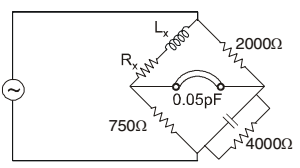Electrical and electronics measurements miscellaneous
- I n the Maxwell bridge as shown in the figure below, the values of resistance Rx and inductance Lx of a coil are to be calculated after balancing the bridge. The component values are shown in the figure at balance. The values of Rx and Lx will respectively be

-
View Hint View Answer Discuss in Forum
Applying the usual balance condition relation,
Z1 Z4 = Z2 Z3.
we have (R1 + jL1ω) 1/R4jC4ω R2R3 R4 + 1/jC4ω or (R1 + jL1ω) R4/jC4ω R2R3 R4 + 1/jC4ω
or R1R4 + jL1ωR4 = R2R3 + jR2R3R4C4ω∴ R1 = R2 R3 L1 = R2R3C4 R4 R1 = 2000 × 750 = 375 ohm. 4000
Lx = 2000 × 750 × 0.05 × 10-6 = 75 mHCorrect Option: A
Applying the usual balance condition relation,
Z1 Z4 = Z2 Z3.
we have (R1 + jL1ω) 1/R4jC4ω R2R3 R4 + 1/jC4ω or (R1 + jL1ω) R4/jC4ω R2R3 R4 + 1/jC4ω
or R1R4 + jL1ωR4 = R2R3 + jR2R3R4C4ω∴ R1 = R2 R3 L1 = R2R3C4 R4 R1 = 2000 × 750 = 375 ohm. 4000
Lx = 2000 × 750 × 0.05 × 10-6 = 75 mH
- Dummy strain gauges are used for
-
View Hint View Answer Discuss in Forum
NA
Correct Option: A
NA
- Which of the following conditions are to be satisfied in the figure shown, so that the common variable shaft of resistance R1 and R2 can be graduated in frequency to measure the frequency of E under balanced condition?

1. R1 = R3
2. C1 = C3
3. R2 = 2R4
4. R2 = R4
Select the correct answer using the codes given below:
-
View Hint View Answer Discuss in Forum
Writing the bridge balance equations:

R1 + 1 
R4 = R2 
R3(1/jC3ω) 
jC1ω R3 + (1/jC3ω) 
R1 + 1 
R4 = R2 R3 jC1ω jR3C3ω + 1 or 
R1 + 1 
(1 + jR3C3ω) = R2R3 jC1ω R4 It gives; R1 + R3 C3 = R2R3 , C1 R4 and R1 + R3C3ω = 1 C1ω or ω = 1 √R1R3C1C3
If C1 = C3, then first equation becomesR1 + R3 = R2R3 R4
Again if R1 = R3 and the common variable short of resistance R1 and R2 can be graduated in frequency to measure the frequency ω. Thus conditions to be satisfied are
C1 = C3, R2 = 2R4, and R1 = R3Correct Option: D
Writing the bridge balance equations:

R1 + 1 
R4 = R2 
R3(1/jC3ω) 
jC1ω R3 + (1/jC3ω) 
R1 + 1 
R4 = R2 R3 jC1ω jR3C3ω + 1 or 
R1 + 1 
(1 + jR3C3ω) = R2R3 jC1ω R4 It gives; R1 + R3 C3 = R2R3 , C1 R4 and R1 + R3C3ω = 1 C1ω or ω = 1 √R1R3C1C3
If C1 = C3, then first equation becomesR1 + R3 = R2R3 R4
Again if R1 = R3 and the common variable short of resistance R1 and R2 can be graduated in frequency to measure the frequency ω. Thus conditions to be satisfied are
C1 = C3, R2 = 2R4, and R1 = R3
- Piezoelectric accelerometers
-
View Hint View Answer Discuss in Forum
NA
Correct Option: B
NA
- The given figure shows wein bridge connection for frequency measurement. C and R are variables and ganged together. For balanced condition the expression for frequency is ƒ = 1/2πCR when

-
View Hint View Answer Discuss in Forum
From the balance equation,
R1 
R + 
= R2 R. 1 1 jωC jωC R + 1 jωC or R1(jωCR + 1) = R2R jωC (jωCR + 1)
or R1 (– C²ω²R² + 1 + 2 jωCR) = jR2CωR
or 2CωRR1 = CωRR2∴ R1 = R2 2
and – C²ω²R² + 1 = 0,or ω = 1 RC or ƒ = 1 2πRC Correct Option: C
From the balance equation,
R1 
R + 
= R2 R. 1 1 jωC jωC R + 1 jωC or R1(jωCR + 1) = R2R jωC (jωCR + 1)
or R1 (– C²ω²R² + 1 + 2 jωCR) = jR2CωR
or 2CωRR1 = CωRR2∴ R1 = R2 2
and – C²ω²R² + 1 = 0,or ω = 1 RC or ƒ = 1 2πRC

